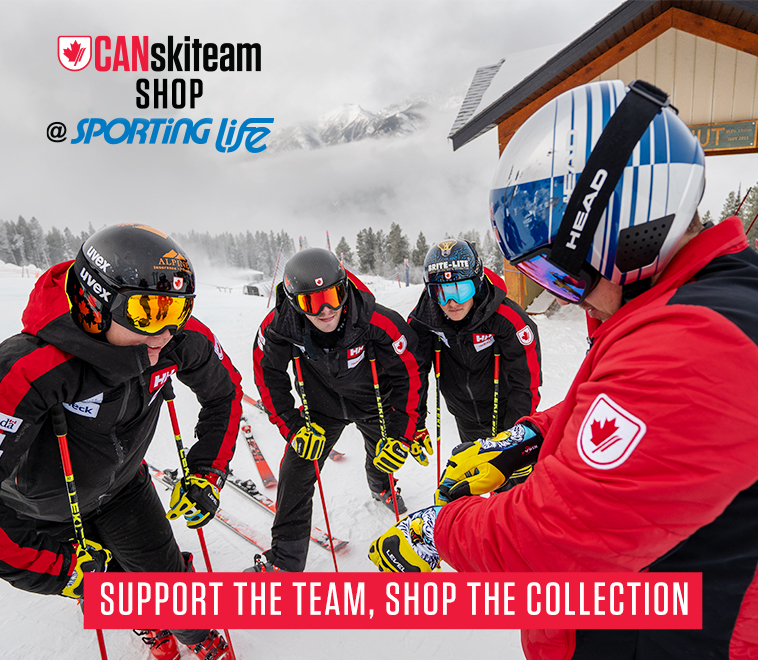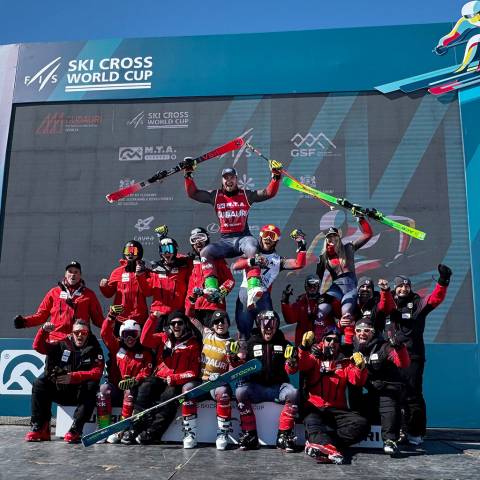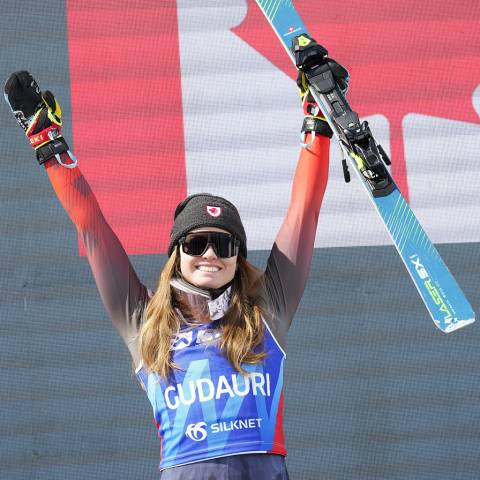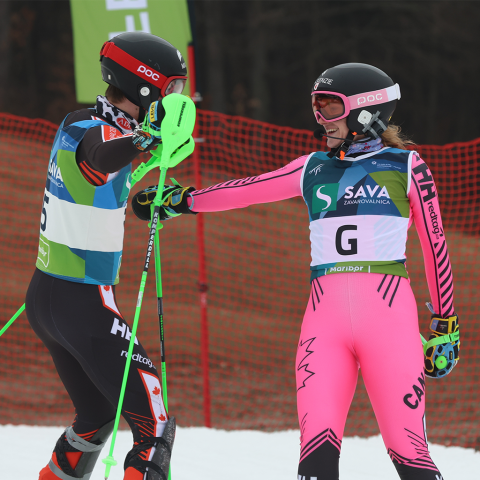Alpine Canada is home to three of Canada’s fastest and most exciting snow sports: alpine, ski cross and para-alpine ski racing. Each sport has a different set of rules, but each athlete has the same goal: get to the bottom of the mountain faster than anyone else.
Over the last half-century, Alpine Canada’s athletes have done just that winning countless world championship medals, Olympic medals, Paralympic medals, X Games medals, and World Cup podiums.
Here’s a look back at some of Alpine Canada’s proudest moments. Please note, complete lists of all medal winners are located at the bottom of this page.
Canadian ski racing officially began on December 20th, 1920, when the Canadian Amateur Ski Association (CASA) was incorporated under the Dominion Charter. The Association consisted of alpine, cross country, and ski jumping as equal partners. While the Association has morphed over time, the excitement and passion for the sport remains the same.
Even though 1920 kicked off the official start of ski racing in Canada the sport was enjoyed long before. In 1904, the Montreal Ski Club, a forerunner for all Canadian ski clubs, was established using the slopes of Mont Royal. In 1905 the club moved north to the Manitou Ski Club in Sainte-Agathe. The train brought avid skiers from Montreal and surrounding areas, establishing the Laurentians as a ski destination that is still sought after today.
When they were incorporated, the Canadian Amateur Ski Association was an honorary member of the Ski Club of Great Britain and was affiliated with the Amateur Athletic Union of Canada, the United States Eastern Amateur Ski Association, and the Fédération Internationale de Ski (FIS) who we remain affiliated with to this day.
The 1930’s saw the introduction of mechanical lifts (rope-tows) as well as FIS sanctioned events; FIS Alpine World Championships in 1931 and the first Winter Olympics to include alpine ski races in 1936.
Alpine Canada’s history of champions started in 1956 when Montreal’s Lucile Wheeler won Canada’s first Olympic alpine medal – a bronze in downhill in Cortina d’Ampezzo, ITA. Two years later, she went on to win double gold at the world championships, starting a Canadian tradition of skiing excellence that would eventually rival any country in the world.
In 1960, Anne Heggtveit became the first Canadian to win an Olympic gold medal in slalom at the Winter Games in Squaw Valley, USA. In 1967, Canada’s Nancy Greene won the World Cup overall title in the very first alpine World Cup season. She went on to win the title again in 1968, the same year she won gold and silver at the Grenoble Olympic Games in giant slalom and slalom. In 1999, Greene was named Canada’s Female Athlete of the Century by the Canadian Press.
Keith Nesbitt, general manager of the Canadian Amateur Ski Association estimated in a December 1969 Maclean’s interview that the contribution skiers make to local economies across Canada was incalculable. The same article declared that “Skiing as a national obsession is somewhat ahead of golf and bowling, which was once Canada’s biggest participatory sport.”
The Canadian Amateur Ski Association changed its name to the Canadian Ski Association (CSA) as the sport continued to grow and divisions (provinces) increased engagement from provincial bodies.
The 1970's started with 16-year-old Betsy Clifford winning the world giant slalom championships and six years later, Kathy Kreiner won Olympic Gold in giant slalom. Also in the '70s, Canada’s Crazy Canucks - including Ken Read, Steve Podborski, Dave Irwin and Dave Murray - conquered race courses with their bold and daring racing style and proved to the world that you didn’t need to be European to win ski races. In 1975, Read became the first non-European man to win a World Cup downhill race. Together, the Crazy Canucks earned 107 top-10 World Cup results from 1978–1984. Podborski still holds the men’s Canadian record of 20 World Cup podiums.
Also during the ‘70s, the Paralympic movement (which had started after wounded World War II veterans returned home) was gaining momentum around the world, and in 1976, the first Paralympic Games were held in Örnsköldsvik, SWE. John Gow won Canada’s first Paralympic alpine gold in slalom.
In the early '80s, Podborski made history when he became the first North American to win an Olympic medal in men's alpine after claiming bronze in downhill at Lake Placid, U.S.A in 1980. Two years later, he became the first North American to win the overall World Cup title in downhill.
At the 1984 Paralympic Games in Innsbruck, AUT, the para-alpine team set a new Canadian record for a single Games, winning 14 alpine medals.
The ‘80s were also a time when Canada's women's alpine skiing team shone, with Gerry Sorensen winning the 1982 world downhill championships and Laurie Graham, Karen Percy and Gerry Sorensen capturing five Olympic and world championship medals combined between 1982 and 1989.
The highlight for the women’s team came in 1988 when Karen Percy, from Banff, Alta., became a hometown hero by winning the first Canadian medal of the Calgary Olympic Games. The 21-year-old won downhill bronze on the seventh day of competition and went on to win another bronze in super-G a few days later.
The ‘90s were a ground-breaking decade for Canada’s downhill skiers.
1993 saw the creation of Alpine Canada and Cross Country Canada as member organizations of the Canadian Ski Association, which took on the name Canadian Snowsports Association in 2001. To this day, Alpine Canada remains a proud member of the CSA, alongside other winter sport organizations. Collectively each organization operates through provincial associations and regional divisions consisting of more than 700 clubs with over 97,000 members.
In 1992, Kerrin Lee-Gartner became the first Canadian to win gold in Olympic downhill at the Games in Albertville, FRA. Kate Pace continued Canada’s downhill domination the following year by winning the world championship title in Morioka, Japan. Then in 1994, Edi Podivinsky grabbed Olympic bronze in downhill in Lillehammer, Norway, a highlight of his 13-year career with Canada’s Alpine Ski Team. Also in 1994, 17-year-old Mélanie Turgeon made her debut, winning five medals, two of them gold in the World Junior Championships. She would go on to win the world downhill championships nine years later (in 2003).
By the end of the decade, a new ski sport was emerging. In 1999, skier X (or ski cross) debuted at the Winter X Games in Aspen, U.S.A, featuring six skiers racing head to head down an extreme course of jumps and banked turns. After the event, the popularity of ski cross spread across North America and Europe and was adopted by the International Ski Federation in 2002 as one of its official ski sports.
The Canadian men’s alpine team began a new era of excellence with Thomas Grandi, a technical specialist, who recorded nine World Cup podiums and inspired the next generation of alpine ski racers. That generation of skiers became known as the Canadian Cowboys.
The Canadian Cowboys – Benjamin Thomsen, Erik Guay, Francois Bourque, Manny Osborne Paradis, John Kucera, Dustin Cook, Mike Janyk and Jan Hudec – were a force on the World Cup tour. In 2009, Kucera became the first Canadian male to win a world championship gold medal in downhill with a famous victory in Val d'Isere, France. The Cowboys made Canada’s men’s team a threat on the world stage once again. In 2009, Kucera became the first Canadian male to win a world championship gold medal in downhill with a famous victory in Val d'Isere, FRA. The Cowboys made Canada’s men’s team a threat on the world stage once again.
While alpine athletes were racking up podiums, Canada was gathering a team of skiers to challenge the ski cross podium at the sport’s first Olympic Games in Vancouver. In 2007, Canada unveiled its first official national ski cross team.
Canada’s para-alpine ski team was making history as well. In 2007, Karolina Wisniewska, eight-time Paralympic medallist, became the first Paralympian to be inducted into the Canadian Ski Hall of Fame.
Canada has dominated the ski cross world from the beginning, with a men’s podium-sweep at the 2010 X Games, and following that with Ashleigh McIvor’s win of the first women’s Olympic ski cross gold medal.
B.C.’s Lauren Woolstencroft won five gold medals at the 2010 Paralympic Games, becoming the first woman ever to do so in a single Games. She retired after that with a career total of 10 Paralympic medals.
The following year, 2011, was also a memorable year for Canadian ski racing, as Chris Del Bosco and Kelsey Serwa won double gold at the ski cross World Championships in Deer Valley, U.S.A, and alpine racer Erik Guay won the downhill at the World Championships in Garmisch-Partenkirchen, Germany.
That same year, Chris Williamson of Markham, Ont. made para-alpine history in Arta Terme, Italy, when he stepped onto the IPC (International Paralympic Committee) World Cup podium for the 100th time in his career.
From 2012 to 2020, Alpine Canada athletes have won Crystal Globes, Olympic medals, and several World Cup races.
The era started with a bang in 2012 when Guay, Jan Hudec, and Ben Thomsen finished 1-3-5 respectively in the World Cup downhill in Chamonix, France. That was the best result on the men’s side since Ed Podvinsky and Cary Mullen came 1-2 in 1994. On the women’s side, Erin Mielzynski captured a gold medal in slalom in Ofterschwang, Germany, becoming the first Canadian to win a World Cup slalom in over 40 years.
Canadians have also enjoyed tremendous success in ski cross since 2012, with Marielle Thompson winning the Crystal Globe three times,and Kevin Drury capturing the first by a Canadian male in 2020. Over two Olympic games, the group has also won five Olympic medals, with Thompson, Brady Leman, and Kelsey Serwa striking gold, with impressive 1-2 results on the women’s side in both 2014 (Serwa) and 2018 (Phelan). As a team, Canada has won four Nation’s Cup titles since 2012 and a grand total of 8.
In Para-Alpine, nine Canadians, including Josh Dueck, Caleb Brousseau, Kimberly Joines, Kurt Oatway, Alex Guimond, Alana Ramsay, Chris Williamson, Mac Marcoux, and Mollie Jepsen have been on the Paralympic podium through two Games. Jepsen made headlines at Pyeongchang 2018, bursting onto the international stage with four medals, including a gold. Mac Marcoux and his guides have also been the epitome of success, winning five Crystal Globes since 2014. In 2020, after retiring, Josh Dueck (who won two medals in the 2014 Games) was named Canada’s chef de mission for the 2022 Paralympics in Beijing, China.
While the Canadian Cowboys were starting their ride into the sunset, Erik Guay landed on the podium twice at 2017 World Championships in St. Mortiz, Switzerland ,winning the super g and earning a silver in the downhill. Erik and teammate Manuel Osborne-Paradis, who captured bronze in the super g on his 33rd birthday, made history the only Canadian men to have stood on the podium together in an alpine skiing world championship.
Since 2012, there has been a passing of the torch on all of the teams, as veterans began making way for young athletes on the World Cup stage. Many of Canada’s up and coming athletes witnessed Canada’s past success and have been inspired by their heroes, who are now guiding them to future glory.
| File Description | Download |
|---|---|
| Paralympic Medallists | pdf (159 KB) |
| FIS World Championship Medallists | pdf (143 KB) |
| Olympic Medallists | pdf (61 KB) |












